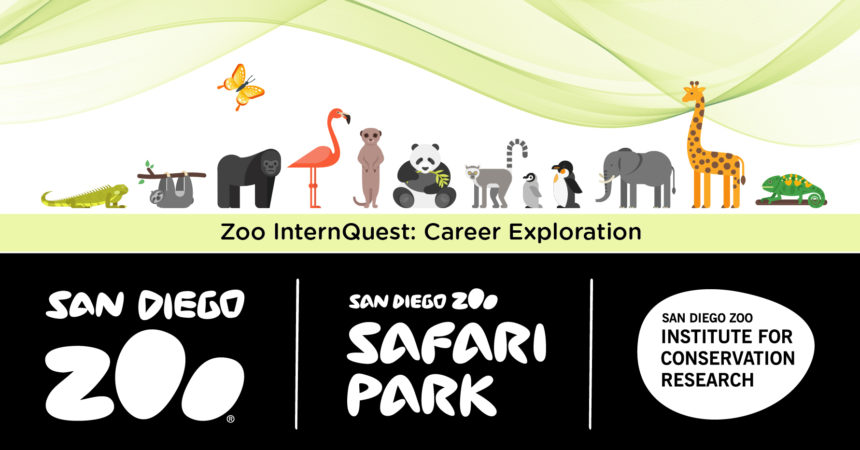Zoo InternQuest is a seven-week career exploration program for San Diego County high school juniors and seniors. Students have the unique opportunity to meet professionals working for the San Diego Zoo, Safari Park, and Institute for Conservation Research, to learn about their jobs, and then blog about their experience online. Follow their adventures here on the Zoo’s website!

Pictured here with Ms. Pillsbury, are the interns in front of a keeper truck.

“Red books” or animal keeper logs are used to record the births, deaths, or any necessary information about the animals being taken care of. Ms. Pillsbury also demonstrated how the ear notching system works. Using different colored tags and ear notch locations representing different identification numbers.
Torrey Pillsbury is more than a Senior Keeper at the San Diego Zoo Safari Park (Park). Ms. Pillsbury is a local San Diegan from Lakeside, who raised animals her whole life, such as dogs, cats, horses, cattle, and sheep. She was part of the 4-H youth organization, which consists of hands-on learning programs for kids of all ages. Part of this program included the opportunity to raise animals, an activity that Ms. Pillsbury enjoyed fully. When she was younger, she thought she wanted to be a teacher. However, at the age of 19, Ms. Pillsbury ended up getting a job at the San Diego Zoo Safari Park, where she worked in the elephant show and trained horses. She then transitioned to her job now, a keeper working in the North Africa, South Africa, and Central Africa field habitats in the Park.

There is a large population of Indian blackbuck in this habitat. There are two males in this photo, yet they appear to be quite different. The male on the left has tan coloring, while the male on the right has black coloring. This is because the ones who are tan were castrated, inhibiting hormone production, while the black males were left intact.
One of the animals Ms. Pillsbury works with daily, is the sitatunga. This swamp-dwelling antelope is native to central Africa. They have a few adaptations that help them thrive in this type of environment. Their long and wide hooves, allow them to easily walk in wet areas and make them great swimmers. Similarly, their soft looking coat is somewhat oily, which benefits them due to its water resistant quality. Their coats are a reddish color that is used as camouflage, but when compared to each other, the sitatunga are hard to tell apart. At the Park, Ms. Pillsbury resolves this issue by utilizing a universal ear notching system that helps identify each individual animal. Similar to getting your ear pierced, this system uses specifically placed V-shaped notches to indicate an animal’s identification number. Keeping track of each individual under her care is a crucial component in maintaining a healthy population. Ms. Pillsbury is constantly observing herd behavior, individual animal health, new births, and more, to ensure that this species thrives.

On the truck ride to the field habitat, the interns picked acacia leaves to be used to feed the giraffes. Ms. Pillsbury discussed her experiences and what she does on a day-to-day basis with the group as we travelled.

Our first animal encounter involved feeding a greater one-horned rhino named Bopu. The interns got to feed him apple slices and experience the sheer size of the rhino up close.
Ms. Pillsbury works with a variety of animals at the Park. As a keeper, the majority of her days are spent outside in the field habitats tracking animals, raking or shoveling, feeding, daily care for the animals, and spreading the message of conservation. Ms. Pillsbury’s days go by quickly as her job keeps her constantly busy with all the enriching tasks that come with the position. What she enjoys most is that every day is different, with changes, challenges, and unforeseen circumstances. If you’d like a career working as a field keeper at the Park, Ms. Pillsbury emphasizes the importance of gaining hands-on experience with animals whether it be through volunteering at shelters or zoos. She even explains how owning and caring for a pet is extremely helpful in developing the responsibility and dedication needed to be a keeper. Ms. Pillsbury highly recommends majoring in animal sciences or zoology for anyone seeking a position working with exotic animals.

The interns were ecstatic to feed the giraffes, that were eagerly coming up to our truck and eating out of our hands. You can have the same experience by booking a Caravan Safari!
A job at the Safari Park is not an easy one, with early hours, working outdoors, and lots of manual labor. It may not be for everyone, however for Ms. Pillsbury the reward is very high. She puts a lot of hard work into watching over such a wide range of species. Working with the animals has been a lifelong passion for her, and you can truly see that she loves what she does. Many of the animals she works with are endangered in the wild, and she takes pride in working for a conservation organization that is striving to bring species back from the brink of extinction.
Week Four
Winter Session 2020


